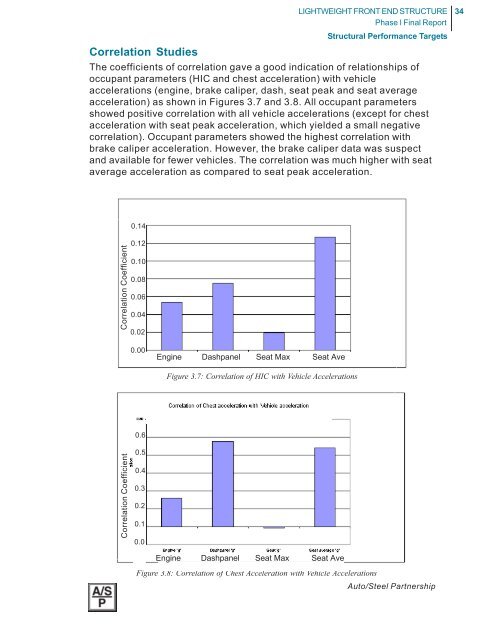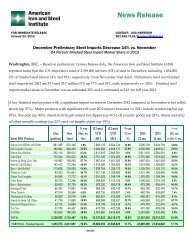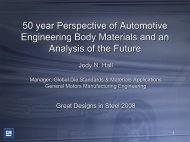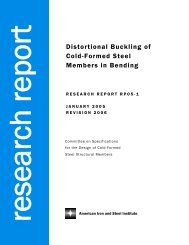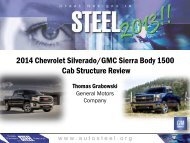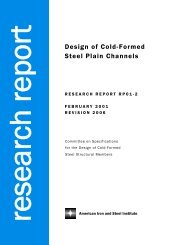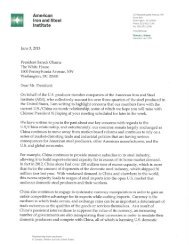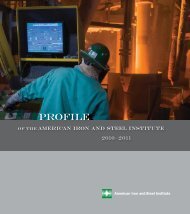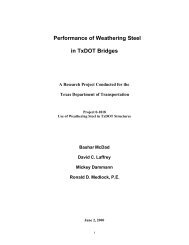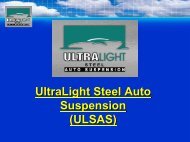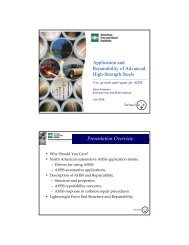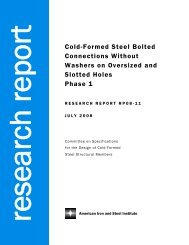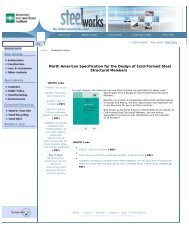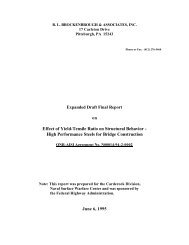- Page 1 and 2: Auto/Steel Partnership
- Page 3 and 4: Contents Introduction..............
- Page 5 and 6: Formability .......................
- Page 7 and 8: LIGHTWEIGHT FRONT END STRUCTURE Pha
- Page 9 and 10: Structural Performance Targets [3]
- Page 11 and 12: Formability Requirements [8] LIGHTW
- Page 13 and 14: Design Space LIGHTWEIGHT FRONT END
- Page 15 and 16: LIGHTWEIGHT FRONT END STRUCTURE Pha
- Page 17 and 18: LIGHTWEIGHT FRONT END STRUCTURE Pha
- Page 19 and 20: LIGHTWEIGHT FRONT END STRUCTURE Pha
- Page 21 and 22: Initial Front End Package LIGHTWEIG
- Page 23 and 24: LIGHTWEIGHT FRONT END STRUCTURE Pha
- Page 25 and 26: Upgraded Front End Package LIGHTWEI
- Page 27 and 28: Figure 2.4: Topological Changes to
- Page 29 and 30: LIGHTWEIGHT FRONT END STRUCTURE Pha
- Page 31 and 32: LIGHTWEIGHT FRONT END STRUCTURE Pha
- Page 33 and 34: LIGHTWEIGHT FRONT END STRUCTURE Pha
- Page 35 and 36: Seat/floor panel peak acceleration
- Page 37: HIC Chest peak acceleration (g) 100
- Page 41 and 42: LIGHTWEIGHT FRONT END STRUCTURE Pha
- Page 43 and 44: Bumper Design LIGHTWEIGHT FRONT END
- Page 45 and 46: umper rail joint. Case Bumper Beam
- Page 47 and 48: LIGHTWEIGHT FRONT END STRUCTURE Pha
- Page 49 and 50: LIGHTWEIGHT FRONT END STRUCTURE Pha
- Page 51 and 52: LIGHTWEIGHT FRONT END STRUCTURE Pha
- Page 53 and 54: LIGHTWEIGHT FRONT END STRUCTURE Pha
- Page 55 and 56: B- Pillar Acceleration (g) 30.0 25.
- Page 57 and 58: LIGHTWEIGHT FRONT END STRUCTURE Pha
- Page 59 and 60: X - Acceleration (g) 35.00 30.00 25
- Page 61 and 62: LIGHTWEIGHT FRONT END STRUCTURE Pha
- Page 63 and 64: 35 30 25 20 15 10 5 0 -5 Figure 4.1
- Page 65 and 66: LIGHTWEIGHT FRONT END STRUCTURE Pha
- Page 67 and 68: LIGHTWEIGHT FRONT END STRUCTURE Pha
- Page 69 and 70: LIGHTWEIGHT FRONT END STRUCTURE Pha
- Page 71 and 72: Parametric Study / LIGHTWEIGHT FRON
- Page 73 and 74: Results Summary LIGHTWEIGHT FRONT E
- Page 75 and 76: LIGHTWEIGHT FRONT END STRUCTURE Pha
- Page 77 and 78: * Baseline values Parameters D.O.E.
- Page 79 and 80: LIGHTWEIGHT FRONT END STRUCTURE Pha
- Page 81 and 82: LIGHTWEIGHT FRONT END STRUCTURE Pha
- Page 83 and 84: LIGHTWEIGHT FRONT END STRUCTURE Pha
- Page 85 and 86: LIGHTWEIGHT FRONT END STRUCTURE Pha
- Page 87 and 88: LIGHTWEIGHT FRONT END STRUCTURE Pha
- Page 89 and 90:
* Baseline values LIGHTWEIGHT FRONT
- Page 91 and 92:
NCAP Parametric Study LIGHTWEIGHT F
- Page 93 and 94:
LIGHTWEIGHT FRONT END STRUCTURE Pha
- Page 95 and 96:
acc (g) 50 40 30 20 10 0 Max B-Pill
- Page 97 and 98:
Normalized Grade Normalized Grade 7
- Page 99 and 100:
Design Variables: Acceleration
- Page 101 and 102:
LIGHTWEIGHT FRONT END STRUCTURE Pha
- Page 103 and 104:
LIGHTWEIGHT FRONT END STRUCTURE Pha
- Page 105 and 106:
X-Acceleration (g) 35 30 25 20 15 1
- Page 107 and 108:
LIGHTWEIGHT FRONT END STRUCTURE Pha
- Page 109 and 110:
Stiffness (N/m) Stiffness (N/m) 60.
- Page 111 and 112:
LIGHTWEIGHT FRONT END STRUCTURE Pha
- Page 113 and 114:
LIGHTWEIGHT FRONT END STRUCTURE Pha
- Page 115 and 116:
LIGHTWEIGHT FRONT END STRUCTURE Pha
- Page 117 and 118:
Normalized SS Normalized SS 50 45 4
- Page 119 and 120:
Normalized Grade Normalized Grade 5
- Page 121 and 122:
LIGHTWEIGHT FRONT END STRUCTURE Pha
- Page 123 and 124:
Intrusion (cm) Intrusion (cm) 30.0
- Page 125 and 126:
Intrusion (cm) Intrusion (cm) 30 25
- Page 127 and 128:
LIGHTWEIGHT FRONT END STRUCTURE Pha
- Page 129 and 130:
Performance Matrix Computer Aided L
- Page 131 and 132:
References 1) Phase I Structural Pe
- Page 133 and 134:
Intrusion (cm) X-Acceleration (g) 4
- Page 135 and 136:
Design Design Mass Saving (Kg) 0 -
- Page 137 and 138:
X-Accel (g) 30 25 20 15 10 5 0 LIGH
- Page 139 and 140:
Optimal Design 7 LIGHTWEIGHT FRONT
- Page 141 and 142:
S. No Part Name LIGHTWEIGHT FRONT E
- Page 143 and 144:
X-Accel (g) 40 35 30 25 20 15 10 5
- Page 145 and 146:
Design Design Mass Delta (Kg) Mass
- Page 147 and 148:
S. No. Part Name Part ID LH Part ID
- Page 149 and 150:
Description Torsional Stiffness (N-
- Page 151 and 152:
LIGHTWEIGHT FRONT END STRUCTURE Pha
- Page 153 and 154:
X-Accel 35 30 25 20 15 10 5 0 LIGHT
- Page 155 and 156:
S. No Part Name DOE Baseline LIGHTW
- Page 157 and 158:
References 1) Phase I Structural Pe
- Page 159 and 160:
LIGHTWEIGHT FRONT END STRUCTURE Pha
- Page 161 and 162:
Figure 8.2: Drawbeads Location Figu
- Page 163 and 164:
Figure 8.7: Formability - Dash Pane
- Page 165 and 166:
Figure 8.11: Formability - Rocker I
- Page 167 and 168:
LIGHTWEIGHT FRONT END STRUCTURE Pha
- Page 169 and 170:
Figure 8.18: Formability - Rail Inn
- Page 171 and 172:
LIGHTWEIGHT FRONT END STRUCTURE Pha
- Page 173 and 174:
LIGHTWEIGHT FRONT END STRUCTURE Pha
- Page 175 and 176:
LIGHTWEIGHT FRONT END STRUCTURE Pha
- Page 177 and 178:
LIGHTWEIGHT FRONT END STRUCTURE Pha
- Page 179 and 180:
LIGHTWEIGHT FRONT END STRUCTURE Pha
- Page 181 and 182:
LIGHTWEIGHT FRONT END STRUCTURE Pha
- Page 183 and 184:
LIGHTWEIGHT FRONT END STRUCTURE Pha
- Page 185 and 186:
LIGHTWEIGHT FRONT END STRUCTURE Pha
- Page 187 and 188:
LIGHTWEIGHT FRONT END STRUCTURE Pha
- Page 189 and 190:
Figure 8.47: Minor Strain Figure 8.
- Page 191 and 192:
LIGHTWEIGHT FRONT END STRUCTURE Pha
- Page 193 and 194:
Figure 8.56: Front Rail Inner - Maj
- Page 195 and 196:
Simulation Results Figure 8.60: Fro
- Page 197 and 198:
LIGHTWEIGHT FRONT END STRUCTURE Pha
- Page 199 and 200:
LIGHTWEIGHT FRONT END STRUCTURE Pha
- Page 201 and 202:
Cost Model LIGHTWEIGHT FRONT END ST
- Page 203 and 204:
LIGHTWEIGHT FRONT END STRUCTURE Pha
- Page 205 and 206:
Knowledge Base LIGHTWEIGHT FRONT EN
- Page 207 and 208:
LIGHTWEIGHT FRONT END STRUCTURE Pha
- Page 209 and 210:
LIGHTWEIGHT FRONT END STRUCTURE Pha
- Page 211 and 212:
LIGHTWEIGHT FRONT END STRUCTURE Pha
- Page 213 and 214:
LIGHTWEIGHT FRONT END STRUCTURE Pha
- Page 215 and 216:
LIGHTWEIGHT FRONT END STRUCTURE Pha
- Page 217:
LIGHTWEIGHT FRONT END STRUCTURE Pha
- Page 220 and 221:
Table of Contents 3 Lightweight Fro
- Page 222 and 223:
List of Tables 5 Lightweight Front
- Page 224 and 225:
4. Results Summary 7 Lightweight Fr
- Page 226 and 227:
Table 2: Grade and Gauge Summary of
- Page 228 and 229:
FE Model Validation (4), (5), (6) 1
- Page 230 and 231:
6. Rail Concept Development Three r
- Page 232 and 233:
Best Hydroformed Design The Hydrofo
- Page 234 and 235:
Best Stamped Design The Stamped Des
- Page 236 and 237:
Figure 11: Bumper Assembly 19 Light
- Page 238 and 239:
Figure 14: Stamped Rail and Attache
- Page 240 and 241:
23 Lightweight Front End Structure
- Page 242 and 243:
B Pillar X-Acceleration (g) . 40 35
- Page 244 and 245:
8. Knowledge Base 27 Lightweight Fr
- Page 246 and 247:
9. Manufacturing 29 Lightweight Fro
- Page 248 and 249:
Thinning < 10% : Design Feasible 31
- Page 250 and 251:
Original Prototyping Processes Fina
- Page 252 and 253:
Figure 22: Front Rail Inner/Outer F
- Page 254 and 255:
Figure 26: Bumper Assembly 37 Light
- Page 256 and 257:
Dimensional Tolerance Analyses 39 L
- Page 258 and 259:
Figure 32: Bumper Tolerances 41 Lig
- Page 260 and 261:
Figure 34: Weld Fixtures Figure 35:
- Page 262 and 263:
Figure 37: NCAP Test - Front View F
- Page 264 and 265:
Figure 41: NCAP Test - Bumper Close
- Page 266 and 267:
12. Conclusions 49 Lightweight Fron
- Page 268 and 269:
14. Appendix A: FE Model Model mass
- Page 270 and 271:
15. Appendix B: Milestone Reports 1
- Page 272 and 273:
16. Appendix C: A/SP Reports A/SP E
- Page 274 and 275:
Abstract 2 Competitive Benchmarking
- Page 276 and 277:
List of Figures 4 Competitive Bench
- Page 278 and 279:
6 Competitive Benchmarking Rigid Fi
- Page 280 and 281:
8 Competitive Benchmarking The foll
- Page 282 and 283:
Figure 5: Rail Deformations at 0ms:
- Page 284 and 285:
Figure 9: Rail Deformations at 40ms
- Page 286 and 287:
3.1. Design 0 This design served as
- Page 288 and 289:
4. Subsystem Comparison 16 Competit
- Page 290 and 291:
Competitive Benchmarking Figure 16:
- Page 292 and 293:
5. Conclusions 20 Competitive Bench
- Page 294 and 295:
8. Appendix A: Animations 22 Prelim
- Page 296 and 297:
Abstract 2 Competitive Benchmarking
- Page 298 and 299:
Competitive Benchmarking List of Fi
- Page 300 and 301:
1. Objectives 6 Competitive Benchma
- Page 302 and 303:
Model/Make Front Rail Cross- Table
- Page 304 and 305:
2002 Honda Accord � Straight rail
- Page 306 and 307:
2003 Toyota Corolla 4 Dr Sedan �
- Page 308 and 309:
5. Conclusions The following design
- Page 310 and 311:
Competitive Benchmarking 8. Appendi
- Page 312 and 313:
2001 VW Golf Figure 11: VW Golf - R
- Page 314 and 315:
Figure 13: VW Golf - Front Rails (i
- Page 316 and 317:
2002 VW Passat Figure 15: VW Passat
- Page 318 and 319:
2001 Mercedes Benz S-500 24 Competi
- Page 320 and 321:
Figure 19: Mercedes Benz S-500 - Fi
- Page 322 and 323:
Figure 22: Honda Accord - Front Rai
- Page 324 and 325:
2002 Honda Civic Figure 24: Honda C
- Page 326 and 327:
Figure 27: Honda Civic - Front Rail
- Page 328 and 329:
2003 Honda Pilot Figure 29: Honda P
- Page 330 and 331:
Figure 33: Lexus LS430 - First Cros
- Page 332 and 333:
Front Rail Rear Rail Front Rail Fig
- Page 334 and 335:
Figure 39: Toyota Camry - Bumper Cr
- Page 336 and 337:
2003 Saturn Ion Figure 42 LH front
- Page 338 and 339:
2002 Saturn VUE Figure 45: LH front
- Page 340 and 341:
2002 Lincoln LS Figure 49: Lincoln
- Page 342 and 343:
Abstract 2 Rail Concept Development
- Page 344 and 345:
List of Figures 4 Rail Concept Deve
- Page 346 and 347:
3. Existing Rail Architecture 6 Rai
- Page 348 and 349:
Figure 3: LH Rail Assembly 8 Rail C
- Page 350 and 351:
Figure 5: Bumper Assembly 10 Rail C
- Page 352 and 353:
Rail Concept Development European p
- Page 354 and 355:
Rail Concept Development sweep, wid
- Page 356 and 357:
4. Best Stamped Design 16 Rail Conc
- Page 358 and 359:
Rail Concept Development The rail c
- Page 360 and 361:
Figure 14: Additional Reinforcement
- Page 362 and 363:
Rail Concept Development Phase I st
- Page 364 and 365:
5. Best Hydroformed Design 24 Rail
- Page 366 and 367:
Figure 20: LH Rail - Plan View 26 R
- Page 368 and 369:
7. Conclusions 28 Rail Concept Deve
- Page 370 and 371:
Validated FE Models Milestone 5 Lig
- Page 372 and 373:
Table of Contents 3 Validated FE Mo
- Page 374 and 375:
1. Objectives 5 Validated FE Models
- Page 376 and 377:
Figure 1: NCAP Full Vehicle FE Mode
- Page 378 and 379:
4. NCAP Response Figure 4: Deformat
- Page 380 and 381:
B Pillar X-Acceleration (g) . B Pil
- Page 382 and 383:
B Pillar X-Velocity (mm/sec) . B Pi
- Page 384 and 385:
5. IIHS Response Figure 14: Deforma
- Page 386 and 387:
Figure 17: Deformation of Front End
- Page 388 and 389:
8. Appendix A: Animations 19 Valida
- Page 390 and 391:
Component Name ID Property Name ID
- Page 392 and 393:
23 Validated FE Models tir2.l 71113
- Page 394 and 395:
25 Validated FE Models trqbox1.r 11
- Page 396 and 397:
27 Validated FE Models ailctr2.l 12
- Page 398 and 399:
29 Validated FE Models foam 9006002
- Page 400 and 401:
31 Validated FE Models tipof bin 90
- Page 402 and 403:
Abstract 2 Enhanced FE Models This
- Page 404 and 405:
List of Figures 4 Enhanced FE Model
- Page 406 and 407:
3. Model Modifications 6 Enhanced F
- Page 408 and 409:
Figure 4: IP Coarse Mesh Model Figu
- Page 410 and 411:
Figure 8: Windshield Coarse Mesh Mo
- Page 412 and 413:
Figure 11: NCAP Full Vehicle FE Mod
- Page 414 and 415:
Figure 15: Deformation of Front End
- Page 416 and 417:
B Pillar X-Acceleration (g) . B Pil
- Page 418 and 419:
Table 5: NCAP Crash Events Time (ms
- Page 420 and 421:
Figure 24: Deformation of Front End
- Page 422 and 423:
6. Conclusions 22 Enhanced FE Model
- Page 424 and 425:
9. Appendix A: Animations 24 Enhanc
- Page 426 and 427:
Component Name 26 Enhanced FE Model
- Page 428 and 429:
28 Enhanced FE Models tir2.l 71113
- Page 430 and 431:
30 Enhanced FE Models trqbox1.r 110
- Page 432 and 433:
32 Enhanced FE Models ailctr2.l 128
- Page 434 and 435:
34 Enhanced FE Models foam 90060029
- Page 436 and 437:
36 Enhanced FE Models tipof bin 900
- Page 438 and 439:
Abstract 2 DOE FE Models This repor
- Page 440 and 441:
List of Figures 4 DOE FE Models Fig
- Page 442 and 443:
were penetrating the ground. Fricti
- Page 444 and 445:
Interference of parts was reduced s
- Page 446 and 447:
Figure 1: Output Locations for NCAP
- Page 448 and 449:
Figure 5: IP Fine Mesh Model Figure
- Page 450 and 451:
Figure 9: Windshield Fine Mesh Mode
- Page 452 and 453:
Figure 13: NCAP Full Vehicle FE Mod
- Page 454 and 455:
Figure 17: Deformation of Front End
- Page 456 and 457:
B Pillar X-Acceleration (g) . B Pil
- Page 458 and 459:
DOE FE Models Table 6: NCAP Crash E
- Page 460 and 461:
Figure 27: Deformation of Front End
- Page 462 and 463:
Intrusion (mm) 40 20 -20 -40 -60 26
- Page 464 and 465:
9. References 1) Validated FE Model
- Page 466 and 467:
11. Appendix B: Summary of FE Model
- Page 468 and 469:
DOE FE Models MTG1 60412 SectShll10
- Page 470 and 471:
DOE FE Models can.1 61106 90060011
- Page 472 and 473:
DOE FE Models outer.1 61209 9006011
- Page 474 and 475:
DOE FE Models fbhplrrnf1.r 61624 Se
- Page 476 and 477:
DOE FE Models out_front_lh_doo 6204
- Page 478 and 479:
Abstract 2 Concept 1 Subsystem Desi
- Page 480 and 481:
List of Figures 4 Concept 1 Subsyst
- Page 482 and 483:
Figure 1: Subsystem of Concept 1 De
- Page 484 and 485:
Concept 1 Subsystem Design The subs
- Page 486 and 487:
Internal Energy (kN-mm) 16000 14000
- Page 488 and 489:
6. References 1) ULSAB Model with U
- Page 490 and 491:
Concept 1: Preliminary Design Miles
- Page 492 and 493:
Table of Contents 3 Concept 1: Prel
- Page 494 and 495:
1. Objectives 5 Concept 1: Prelimin
- Page 496 and 497:
Figure 2: Reinforcements Removed 7
- Page 498 and 499:
Figure 4: New Bumper Design 9 Conce
- Page 500 and 501:
4. FE Model - Output Location Summa
- Page 502 and 503:
5. NCAP Response The figures below
- Page 504 and 505:
B Pillar X-Velocity (mm/sec) . B Pi
- Page 506 and 507:
6. IIHS Response IIHS intrusions ar
- Page 508 and 509:
7. Conclusions 19 Concept 1: Prelim
- Page 510 and 511:
10. Appendix A: Animations 21 Conce
- Page 512 and 513:
Concept 1: Preliminary Design rrcrd
- Page 514 and 515:
Concept 1: Preliminary Design ep_70
- Page 516 and 517:
Concept 1: Preliminary Design modpl
- Page 518 and 519:
Concept 1: Preliminary Design drlwh
- Page 520 and 521:
Concept 1: Preliminary Design accl.
- Page 522 and 523:
Concept 1: DOE Study Milestone 11 L
- Page 524 and 525:
Table of Contents 3 Concept 1: DOE
- Page 526 and 527:
1. Objectives 5 Concept 1: DOE The
- Page 528 and 529:
4. FE Model - Output Location Summa
- Page 530 and 531:
Concept 1: DOE Figure 4-6 show the
- Page 532 and 533:
6. Conclusions 11 Concept 1: DOE An
- Page 534 and 535:
9. Appendix A: Concept1 Baseline FE
- Page 536 and 537:
Concept 1: DOE MTG1 60412 SectShll1
- Page 538 and 539:
Concept 1: DOE can2 61105 90060010
- Page 540 and 541:
Concept 1: DOE bintongue 61208 9006
- Page 542 and 543:
Concept 1: DOE fbhplrrnf1.l 61623 S
- Page 544 and 545:
23 Concept 1: DOE SpotWelds 62039 N
- Page 546 and 547:
Abstract 2 Concept 1: Final Design
- Page 548 and 549:
List of Figures 4 Concept 1: Final
- Page 550 and 551:
Concept 1: Final Design The Final D
- Page 552 and 553:
Part Baseline Design Table 5: Grade
- Page 554 and 555:
Figure 2: Output Locations for NCAP
- Page 556 and 557:
B Pillar X-Acceleration (g) . B Pil
- Page 558 and 559:
6. IIHS Response IIHS intrusions ar
- Page 560 and 561:
7. Conclusions 16 Concept 1: Final
- Page 562 and 563:
10. Appendix A: Animations 18 Conce
- Page 564 and 565:
Concept 1: Final Design Component N
- Page 566 and 567:
Concept 1: Final Design Component N
- Page 568 and 569:
Concept 1: Final Design Component N
- Page 570 and 571:
Concept 1: Final Design Component N
- Page 572 and 573:
Concept 1: Final Design Component N
- Page 574 and 575:
Concept 2: Preliminary Design Miles
- Page 576 and 577:
Table of Contents 3 Concept 2: Prel
- Page 578 and 579:
1. Objectives 5 Concept 2: Prelimin
- Page 580 and 581:
Figure 2: LH Inner & Outer Rails 7
- Page 582 and 583:
Figure 4: LH Skirt Reinforcement 9
- Page 584 and 585:
Figure 6: New Bumper Design - Close
- Page 586 and 587:
13 Concept 2: Preliminary Design Ta
- Page 588 and 589:
Figure 8: Output Locations for NCAP
- Page 590 and 591:
B Pillar X-Velocity (mm/sec) . B Pi
- Page 592 and 593:
6. IIHS Response IIHS intrusions ar
- Page 594 and 595:
9. References 1) Validated FE Model
- Page 596 and 597:
11. Appendix B: Summary of FE Model
- Page 598 and 599:
Abstract 2 Concept 1: Preliminary D
- Page 600 and 601:
List of Figures 4 Concept 1: Prelim
- Page 602 and 603:
3. DOE Responses 6 Concept 1: Preli
- Page 604 and 605:
Concept 2: Final Design Milestone 1
- Page 606 and 607:
Table of Contents 3 Concept 2: Fina
- Page 608 and 609:
1. Objectives 5 Concept 2: Final De
- Page 610 and 611:
Outboard Rail Figure 2: LH Inner &
- Page 612 and 613:
Figure 4: New Bumper Design 9 Conce
- Page 614 and 615:
Figure 6: Bumper Attachment 11 Conc
- Page 616 and 617:
4. FE Model - Output Location Summa
- Page 618 and 619:
The figures below summarize the NCA
- Page 620 and 621:
Concept 2: Final Design Table 6: NC
- Page 622 and 623:
7. Conclusions 19 Concept 2: Final
- Page 624 and 625:
10. Appendix A: Animations 21 Conce
- Page 626 and 627:
Concept 1: Preliminary Design lcarn
- Page 628 and 629:
Concept 1: Preliminary Design tire1
- Page 630 and 631:
Concept 1: Preliminary Design pivot
- Page 632 and 633:
Concept 1: Preliminary Design fdrbd
- Page 634 and 635:
Concept 1: Preliminary Design rbmpb
- Page 636 and 637:
12. Appendix C: Attached Parts Figu
- Page 638 and 639:
Figure 24: Front Cradle Mount 36 Co
- Page 640 and 641:
Figure 26: Torque Box 38 Concept 1:
- Page 642 and 643:
Figure 28: Battery 40 Concept 1: Pr
- Page 644 and 645:
Concept 3: Preliminary Design Miles
- Page 646 and 647:
Table of Contents 3 Concept 1: Prel
- Page 648 and 649:
1. Objectives 5 Concept 1: Prelimin
- Page 650 and 651:
Figure 3: LH Rail - Isometric View
- Page 652 and 653:
Concept 1: Preliminary Design The r
- Page 654 and 655:
Figure 9: New Bumper Design - Half
- Page 656 and 657:
Figure 10: Output Locations for NCA
- Page 658 and 659:
B Pillar X-Velocity (mm/sec) . 4000
- Page 660 and 661:
6. IIHS Response 17 Concept 1: Prel
- Page 662 and 663:
Toepan Right Intrusion (mm) A-B Pil
- Page 664 and 665:
9. References 1) Validated FE Model
- Page 666 and 667:
11. Appendix B: Summary of FE Model
- Page 668 and 669:
Concept 1: Preliminary Design tieba
- Page 670 and 671:
Concept 1: Preliminary Design upper
- Page 672 and 673:
Concept 1: Preliminary Design outer
- Page 674 and 675:
Concept 1: Preliminary Design gusse
- Page 676 and 677:
Concept 1: Preliminary Design out_r
- Page 678 and 679:
Figure 22: Attached Parts - Side Vi
- Page 680 and 681:
Figure 25: Suspension Panel 37 Conc
- Page 682 and 683:
Figure 27: Rear Cradle Mount 39 Con
- Page 684 and 685:
Figure 29: Tie Bar 41 Concept 1: Pr
- Page 686 and 687:
Abstract 2 Concept 3: DOE This repo
- Page 688 and 689:
List of Figures 4 Concept 3: DOE Fi
- Page 690 and 691:
3. DOE Model 6 Concept 3: DOE The D
- Page 692 and 693:
Figure 2: Output Locations for NCAP
- Page 694 and 695:
Norm SS 30 25 20 Norm SS 15 10 5 0
- Page 696 and 697:
8. References 1) Validated FE Model
- Page 698 and 699:
Concept 3: Final Design Milestone 1
- Page 700 and 701:
Table of Contents 3 Concept 3: Fina
- Page 702 and 703:
1. Objectives 5 Concept 3: Final De
- Page 704 and 705:
Figure 3: LH Rail - Isometric View
- Page 706 and 707:
9 Concept 3: Final Design The rail
- Page 708 and 709:
Figure 9: New Bumper Design - Half
- Page 710 and 711:
Figure 10: Output Locations for NCA
- Page 712 and 713:
B Pillar X-Velocity (mm/sec) . 4000
- Page 714 and 715:
6. IIHS Response 17 Concept 3: Fina
- Page 716 and 717:
Toepan Right Intrusion (mm) A-B Pil
- Page 718 and 719:
9. References 1) Validated FE Model
- Page 720 and 721:
11. Appendix B: Summary of FE Model
- Page 722 and 723:
25 Concept 3: Final Design tiebar4.
- Page 724 and 725:
27 Concept 3: Final Design ai_icebo
- Page 726 and 727:
29 Concept 3: Final Design part.15
- Page 728 and 729:
31 Concept 3: Final Design rrhdr 61
- Page 730 and 731:
12. Appendix C: Attached Parts Figu
- Page 732 and 733:
Figure 24: Front Cradle Mount 35 Co
- Page 734 and 735:
Figure 26: Torque Box 37 Concept 3:
- Page 736 and 737:
Figure 28: Battery 39 Concept 3: Fi
- Page 738 and 739:
Bumper Formability Milestone 19 Lig
- Page 740 and 741:
Table of Contents 3 Bumper Formabil
- Page 742 and 743:
1. Objectives 5 Bumper Formability
- Page 744 and 745:
Figure 2: New Bumper Design - Close
- Page 746 and 747:
4. Bumper Formability Results 9 Bum
- Page 748 and 749:
Target Thinning
- Page 750 and 751:
Figure 7: Bumper Outer - FLD Curve
- Page 752 and 753:
7. References 1) Validated FE Model
- Page 754 and 755:
NCAP DOE Response Surface Milestone
- Page 756 and 757:
Table of Contents 3 NCAP DOE Respon
- Page 758 and 759:
1. Objectives 5 NCAP DOE Response S
- Page 760 and 761:
Figure 2: LH Rail Assembly 7 NCAP D
- Page 762 and 763:
Rail Extension 3. NCAP Response Sur
- Page 764 and 765:
Figure 5: Output Locations for NCAP
- Page 766 and 767:
7. References 1) Validated FE Model
- Page 768 and 769:
Abstract 2 IIHS DOE Response Surfac
- Page 770 and 771:
List of Figures 4 IIHS DOE Response
- Page 772 and 773:
Figure 1: Bumper 6 IIHS DOE Respons
- Page 774 and 775:
Outboard Rail Figure 3: LH Inner &
- Page 776 and 777:
4. FE Model - Output Location Summa
- Page 778 and 779:
5. Conclusions 12 IIHS DOE Response
- Page 780 and 781:
Final Optimized Design Milestone 22
- Page 782 and 783:
Table of Contents 3 Final Optimized
- Page 784 and 785:
1. Objectives 5 Final Optimized Des
- Page 786 and 787:
Table 3: Static Stiffness Results 7
- Page 788 and 789:
Rail Extension Rail Extension Reinf
- Page 790 and 791:
Figure 5: New Bumper Design - Close
- Page 792 and 793:
4. FE Model - Output Location Summa
- Page 794 and 795:
5. NCAP Response The figures below
- Page 796 and 797:
6. IIHS Response IIHS intrusions ar
- Page 798 and 799:
9. References 1) Validated FE Model
- Page 800 and 801:
11. Appendix B: Summary of FE Model
- Page 802 and 803:
Abstract 2 Analysis of Vehicle With
- Page 804 and 805:
List of Figures 4 Analysis of Vehic
- Page 806 and 807:
3. Modifications to Final Design 6
- Page 808 and 809:
Figure 2: Front Cradle Mounts Figur
- Page 810 and 811:
Figure 6: Rail Extension Welds A ma
- Page 812 and 813:
4. FE Model - Output Location Summa
- Page 814 and 815:
5. NCAP Response 14 Analysis of Veh
- Page 816 and 817:
vel (mm/sec) 4000 2000 -4000 -6000
- Page 818 and 819:
8. References 1) Validated FE Model
- Page 820 and 821:
10. Appendix B: Summary of FE Model
- Page 823 and 824:
Table of Contents Section Descripti
- Page 825 and 826:
List of Figures Number Title Page 1
- Page 827 and 828:
List Of Photographs, Cont'd. Descri
- Page 829 and 830:
Purpose This 56 km/h (35 mph) front
- Page 831 and 832:
Section 2.0 Impact Test Summary 2-1
- Page 833 and 834:
Data Acquisition Explanations The p
- Page 835 and 836:
Table 2 General Test and Vehicle Pa
- Page 837 and 838:
Test vehicle's target test weight:
- Page 839 and 840:
Table 3 Post-Impact Data Test type:
- Page 841 and 842:
Figure 2 Load Cell Barrier Configur
- Page 843 and 844:
3 7 4 5 3 4 6 5 6 Figure 3 Vehicle
- Page 845 and 846:
Figure 4 Vehicle Crush Data Vehicle
- Page 847 and 848:
Figure 5 Vehicle Intrusion Measurem
- Page 849 and 850:
I L K J M Figure 7 Vehicle Intrusio
- Page 851 and 852:
Figure 9 Vehicle Toeboard Measureme
- Page 853 and 854:
2 6 7 4 5 3 Figure 10 Camera Positi
- Page 855 and 856:
Figure 11 Vehicle Reference Photo T
- Page 857 and 858:
Figure A-1 Pre-Test Front View Figu
- Page 859 and 860:
Figure A-5 Pre-Test Left Side View
- Page 861 and 862:
Figure A-9 Pre-Test Rear View Figur
- Page 863 and 864:
Figure A-13 Pre-Test Right Side Vie
- Page 865 and 866:
Figure A-17 Pre-Test Overhead View
- Page 867 and 868:
Figure A-20 Pre-Test Front Underbod
- Page 869 and 870:
Figure A-24 Pre-Test Mid Underbody
- Page 871 and 872:
Figure A-28 Pre-Test Rear Underbody
- Page 873 and 874:
Figure A-32 Pre-Test Fuel Filler Ne
- Page 875 and 876:
Figure A-35 Pre-Test Windshield Vie
- Page 877 and 878:
Figure A-39 Pre-Test Right Front Wi
- Page 940:
Appendix C Miscellaneous Test Instr
- Page 945 and 946:
Frequency Response Classes SAE J211
- Page 947 and 948:
Correlation of Vehicle With New Rai
- Page 949 and 950:
Correlation of Vehicle With New Rai
- Page 951 and 952:
3. NCAP Response Correlation of Veh
- Page 953 and 954:
Correlation of Vehicle With New Rai
- Page 955 and 956:
Correlation of Vehicle With New Rai
- Page 957 and 958:
acc (g) acc (g) 50 40 30 20 10 0 50
- Page 959 and 960:
force (N) 1.0E+06 9.0E+05 8.0E+05 7
- Page 961 and 962:
Correlation of Vehicle With New Rai
- Page 963 and 964:
7. References 1) Validated FE Model
- Page 965 and 966:
9. Appendix B: Summary of FE Model
- Page 967 and 968:
Table of Contents Proteus Guideline
- Page 969 and 970:
Table of Contents 1 Introduction...
- Page 971 and 972:
1 Introduction Proteus Guidelines T
- Page 973 and 974:
Powertrain Front-end Package of Pha
- Page 975 and 976:
• LH and RH Pulse - NCAP B-pillar
- Page 977 and 978:
7.1 Online Help Click on the Help o
- Page 979 and 980:
Add or Delete an Architecture Click
- Page 981 and 982:
7.4 Compute Response Scroll down th
- Page 983 and 984:
DoE Parameters Click on the Paramet
- Page 985 and 986:
Error Plots Click on the Error Grap
- Page 987 and 988:
7.5 Load a Design from the Library
- Page 989 and 990:
Deleting a User Design Click on the
- Page 991 and 992:
7.8 Optimize Design Click on the Op
- Page 993 and 994:
Figure 16: Proteus Optimizer Page
- Page 995 and 996:
Initial Front-End Package: Phase I
- Page 997 and 998:
Initial Front-End Package: Phase I
- Page 999 and 1000:
1 18 17 4 5 Figure 1: Front-End Par
- Page 1001 and 1002:
18 20 17 8 10 4 5 9 6 Figure 3: Fro
- Page 1003 and 1004:
4/27 9/33 5/28 17/31 6/29 9/30 1/24
- Page 1005 and 1006:
Normalized Grade -13.8 -12.7 700 MP
- Page 1007 and 1008:
Table of Contents 1 Front-End DoE P
- Page 1009 and 1010:
34 Panel Body Side Outer Top & B-Pi
- Page 1011 and 1012:
19 21 17 6 4 18 5 16 9 Figure 1: Fr
- Page 1013 and 1014:
S.N. 1 2 Table 4: Topological Param
- Page 1015 and 1016:
Normalized Grade 500 MPa 2 1 Overal
- Page 1017 and 1018:
4 IIHS Study of Upgraded Front-End
- Page 1019 and 1020:
18/39 4/27 17/ 38 21/42 5/28 6/29 2
- Page 1021 and 1022:
Stamped Design: Phase II Lightweigh
- Page 1023 and 1024:
1 DOE Parts Rail Front Inner/Outer
- Page 1025 and 1026:
3 NCAP/IIHS Studies The NCAP/IIHS D
- Page 1027 and 1028:
4 References 1) DOE FE Models, Mile
- Page 1029 and 1030:
Abstract 2 Static Dynamic Stiffness
- Page 1031 and 1032:
1. Objectives 4 Static Dynamic Stif
- Page 1033 and 1034:
Corrected Displacement in mm Correc
- Page 1035 and 1036:
Static Stiffness DOE Response Surfa
- Page 1037 and 1038:
Table of Contents 3 Static Stiffnes
- Page 1039 and 1040:
Figure 1: Bumper Figure 2: LH Rail
- Page 1041 and 1042:
Rail Extension 3. Model Modificatio
- Page 1043 and 1044:
Figure 6: Final Concept 2 Design BI
- Page 1045 and 1046:
Corrected Theta in degrees Correcte
- Page 1047 and 1048:
Dynamic Stiffness DOE Response Surf
- Page 1049 and 1050:
Table of Contents 3 Dynamic Stiffne
- Page 1051 and 1052:
Figure 1: Bumper Figure 2: LH Rail
- Page 1053 and 1054:
Rail Extension 3. Model Modificatio
- Page 1055 and 1056:
Figure 6: Final Concept 2 Design BI
- Page 1057:
5. Conclusions 11 Dynamic Stiffness


